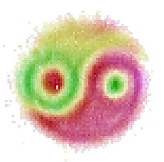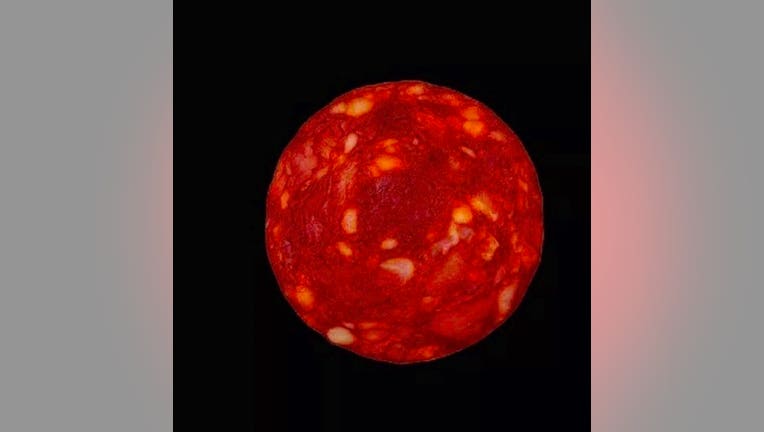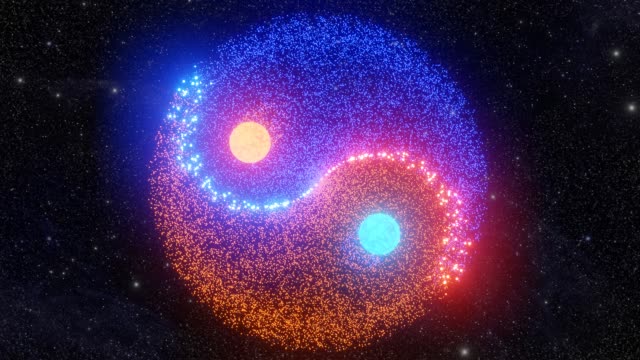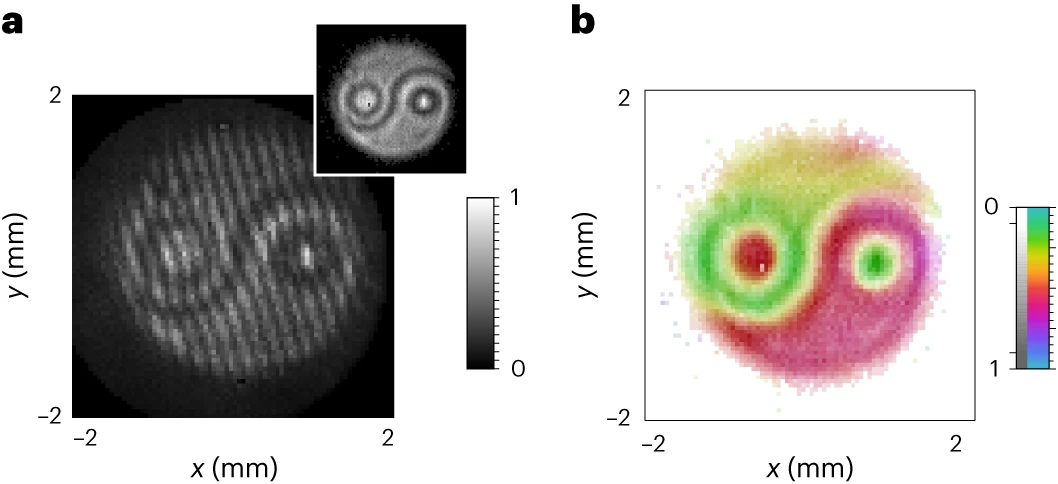-
 Gnomon
4.3kThe recent publication of a cutting-edge physics experiment revealed that entangled photons returned a holographic image that looks identical to the Yin/Yang symbol of Taoism and Holism. The article was quickly reproduced in other publications, but I was surprised that no one expressed surprise at the irony that a state-of-the-art Western scientific photographic technique produced an image traditionally used to symbolically portray the holistic philosophical worldview of an ancient Eastern philosophy.
Gnomon
4.3kThe recent publication of a cutting-edge physics experiment revealed that entangled photons returned a holographic image that looks identical to the Yin/Yang symbol of Taoism and Holism. The article was quickly reproduced in other publications, but I was surprised that no one expressed surprise at the irony that a state-of-the-art Western scientific photographic technique produced an image traditionally used to symbolically portray the holistic philosophical worldview of an ancient Eastern philosophy.
Since the philosophy of Holism is typically considered to be antithetical to the method of Reductionism, characteristic of Western Science, I thought this presumably-objective evidence might provide fodder for a calm intellectual dialog on this rational philosophical forum. BTW, the "holographic" heading below is intended to be both provocative and tongue-in-cheek. The relevant question here : is the image a mere coincidence or a consonance? :smile:
PS__A secondary question that might be illuminated : is this forum polarized along physics vs metaphysics, eastern vs western, science vs philosophy lines on an evocative topic like this? Or is it open to Consilience, as suggested by beleaguered biologist E. O. Wilson?
PPS__Tertiary question : Is a wave-function a physical particle or a symbolic-metaphysical-mental-mathematical concept, or . . . . ?
YIN/YANG PHYSICS & SEMIOLOGY

Holographic image reveals Holistic nature of Nature :
Researchers at the University of Ottawa, . . . . recently demonstrated a novel technique that allows the visualization of the wave function of two entangled photons, the elementary particles that constitute light, in real-time.
https://phys.org/news/2023-08-visualizing-mysterious-quantum-entanglement-photons.html
Consilience : agreement between the approaches to a topic of different academic subjects, especially science and the humanities.
https://en.wikipedia.org/wiki/Consilience_(book)
Entanglement is a mysterious quantum phenomenon that is widely, but mistakenly, described as capable of transmitting information over vast distances faster than the speed of light. It has proved very popular with science writers, philosophers of science, and many scientists who hope to use the mystery to deny some of the basic concepts underlying quantum physics. Beyond this claim, which violates the principle of relativity, is the claim that entanglement "connects" every particle in the universe with every other particle, implying a "holistic" or "implicate" order in the universe, which is popular with "new age" thinkers and other mystics who see in it pan-psychism, or "cosmic consciousness," or at a minimum "telepathic powers" between entangled minds.
https://www.informationphilosopher.com/problems/entanglement/ -
 T Clark
16kThe recent publication of a cutting-edge physics experiment revealed that entangled photons returned a holographic image that looks identical to the Yin/Yang symbol of Taoism and Holism. The article was quickly reproduced in other publications, but I was surprised that no one expressed surprise at the irony that a state-of-the-art Western scientific photographic technique produced an image traditionally used to symbolically portray the holistic philosophical worldview of an ancient Eastern philosophy. — Gnomon
T Clark
16kThe recent publication of a cutting-edge physics experiment revealed that entangled photons returned a holographic image that looks identical to the Yin/Yang symbol of Taoism and Holism. The article was quickly reproduced in other publications, but I was surprised that no one expressed surprise at the irony that a state-of-the-art Western scientific photographic technique produced an image traditionally used to symbolically portray the holistic philosophical worldview of an ancient Eastern philosophy. — Gnomon
After slogging through the original paper (link - https://www.nature.com/articles/s41566-023-01272-3#Fig2) I think I've sort of figured it out. Not certain. If I'm right, you've misunderstood what's really going on. The input to the experiment was the image of the yin/yang symbol. It was disrupted and then recreated using the new holographic/entangled photon technique. Somebody else take a look and see if they think I'm right.
I don't know why they used that symbol. Seems like a confusing choice given the possibilities for misunderstanding. -
 Count Timothy von Icarus
4.3kCounterpoint: Jesus with a halo praying carved into the universe with a nebula.
Count Timothy von Icarus
4.3kCounterpoint: Jesus with a halo praying carved into the universe with a nebula.

Or you have the Virgin Mary showing up in the streaks from glass cleaning, burnt toast, and other chaotic phenomena. -
 T Clark
16kCounterpoint: Jesus with a halo praying carved into the universe with a nebula. — Count Timothy von Icarus
T Clark
16kCounterpoint: Jesus with a halo praying carved into the universe with a nebula. — Count Timothy von Icarus
As I noted, it's not a case of reading meaning into a pattern. The yin/yang pattern was intentionally used by the experimenters as part of the experiment. -
 Count Timothy von Icarus
4.3k
Count Timothy von Icarus
4.3k
Ah, even less can it match up then. Behold!

I think they put the flowers there after the barky miracle. To me, it looks more like she is holding a pumpkin than a baby or praying though.
But that's the whole thing about signs, they only convey meaning based on what has come before. To the right eye, there is plenty there, I'm sure. Semiosis is sort of spooky and magical in general. I have been going to a non-denominational, Protestant Church for a long time, and they don't really have the same "eye" for the Blessed Virgin that Catholics and the Orthodox do. -
 punos
796Somebody else take a look and see if they think I'm right. — T Clark
punos
796Somebody else take a look and see if they think I'm right. — T Clark
Yes, you are correct. The image used in the experiment is arbitrary, they could have used Mickey Mouse or any other image. I think a Lambda symbol was used in a prior version of the experiment.
This video came up in my YouTube feed a few days ago:
-
 Gnomon
4.3k
Gnomon
4.3k
Is it your understanding that the scientists took a picture of a cultural symbol, and published it as-if it's a picture of two photons orbiting each other?*4 If so, was it a joke on gullible New Agers?*5 Or were they deliberately trying to deceive us ignorant Philosophers? Either way, it's unprofessional behavior. Please post a quote from your source that says "The input to the experiment was the image of the yin/yang symbol", so we can "take a look".After slogging through the original paper (link - https://www.nature.com/articles/s41566-023-01272-3#Fig2) I think I've sort of figured it out. Not certain. If I'm right, you've misunderstood what's really going on. The input to the experiment was the image of the yin/yang symbol. It was disrupted and then recreated using the new holographic/entangled photon technique. Somebody else take a look and see if they think I'm right. — T Clark
The articles I've seen don't mention that they started with a yin/yang symbol as input. But the article*1 below says : "This leaves scientists with the onerous task of painstakingly weeding out nonsensical, unphysical states, an effort that can take hours or even days depending on a system's complexity.
To get around this, the researchers used holography to encode information from higher dimensions into manageable, lower-dimensional chunks". That sounds pretty devious in itself. Especially, since the particular nature of a photon seems to be imaginary*2, as a way to envision a mathematical wave consisting of abstract numbers, not concrete matter.
The "real space" images*3 below portray a single photon (i.e. wavefunction) in the form of concentric rings, as we might imagine an elementary particle. But the image covers the evolution of the wavefront over time. So, it's not exactly a snap-shot.
In the OP I noted that I was not taking this "coincidence" seriously, but with tongue-in-cheek. One purpose was to see if others would also take it with good humor. So far, so-so. :smile:
*1. Quantum 'yin-yang' shows two photons being entangled in real-time :
Scientists have used a first-of-its-kind technique to visualize two entangled light particles in real time — making them appear as a stunning quantum "yin-yang" symbol.
https://www.livescience.com/physics-mathematics/quantum-physics/quantum-yin-yang-shows-two-photons-being-entangled-in-real-time
*2. Is the photon really a particle? :
Photons deliver their energy and momentum to a point on a material target. It is commonplace to attribute this to particle impact. But since the in-flight photon also has a wave nature, we are stuck with the paradox of wave-particle duality. It is argued here that the photon’s wave nature is indisputable, but its particle nature is open to question.
https://www.sciencedirect.com/science/article/pii/S0030402621003983
*3. Real-space image of the photon part of the wave function :

https://www.researchgate.net/figure/Real-space-image-of-the-photon-part-of-the-wave-function-showing-evolution-of-a-Gaussian_fig1_6769263
*4. PEPPERONI STAR HOAX

https://www.fox5ny.com/news/scientist-apologizes-after-photo-of-star-turns-out-to-be-slice-of-chorizo
*5. JOY Joke's On You

-
 T Clark
16kIs it your understanding that the scientists took a picture of a cultural symbol, and published it as-if it's a picture of two photons orbiting each other?*4 If so, was it a joke on gullible New Agers?*5 Or were they deliberately trying to deceive us ignorant Philosophers? — Gnomon
T Clark
16kIs it your understanding that the scientists took a picture of a cultural symbol, and published it as-if it's a picture of two photons orbiting each other?*4 If so, was it a joke on gullible New Agers?*5 Or were they deliberately trying to deceive us ignorant Philosophers? — Gnomon
No, you've completely misunderstood. As @punos noted:
The image used in the experiment is arbitrary, they could have used Mickey Mouse or any other image. I think a Lambda symbol was used in a prior version of the experiment. — punos
They made a bad choice in using the taiji because gullible new-agers could so easily jump to the incorrect conclusion without understanding the substance of the experiment.
The articles I've seen don't mention that they started with a yin/yang symbol as input. — Gnomon
You're right, the people who wrote the articles either didn't understand just as you didn't or were unaware of possible misinterpretations. Take a look at the original article. The symbol does not play a big role in the results. It is only really discussed in a caption to one of the figures. -
 flannel jesus
2.9kThey made a bad choice in using the taichi because gullible new-agers could so easily jump to the incorrect conclusion without understanding the substance of the experiment. — T Clark
flannel jesus
2.9kThey made a bad choice in using the taichi because gullible new-agers could so easily jump to the incorrect conclusion without understanding the substance of the experiment. — T Clark
Quantum physics seems ripe for certain kinds of thinkers to abuse. It takes a lot of effort to undo that abuse . -
 T Clark
16kQuantum physics seems ripe for certain kinds of thinkers to abuse. It takes a lot of effort to undo that abuse . — flannel jesus
T Clark
16kQuantum physics seems ripe for certain kinds of thinkers to abuse. It takes a lot of effort to undo that abuse . — flannel jesus
Agreed. -
 Alkis Piskas
2.1k
Alkis Piskas
2.1k
Gnomon, Fritjof Capra has talked about this subject extensively since 1975 in his famous book "The Tao of Physics: An Exploration of the Parallels Between Modern Physics and Eastern Mysticism"

-
 Gnomon
4.3k
Gnomon
4.3k
I certainly don't understand why an attempt to create an image of a "physical" object would require the inclusion of a completely unrelated image. Which part of the published picture are we supposed to identify with the entangled wavefunctions? Even if the swirling dots are supposed to be entwined photons, what scientific meaning are we supposed to learn from the image? An artist could have done the same with much less technological tomfoolery. Were the scientists themselves "gullible new-agers" trying to send a message to blind black-&-whiters?No, you've completely misunderstood. As punos noted:
They made a bad choice in using the taiji because gullible new-agers could so easily jump to the incorrect conclusion without understanding the substance of the experiment. — T Clark
The whole idea of photographing photons sounds like trying to catch lightning in a klein bottle. I watched Anton's video clip, but I'm still confused*1. I'd still like to see a quote from the article you referenced ; to help me understand why they needed an image within the image. Not because I'm a New Ager, but because I'm an amateur philosopher, who is interested in both Quantum Physics and Causal Information. It's kind of my thing on this forum. :smile:
*1. Is he accusing the scientists of stupidity or deliberate deception?
@GIRGHGH : For anyone still confused, what he's basically saying is that it's a fancy photograph of a literal physical object.
https://www.youtube.com/watch?v=3f4yAIj9ZL8
Note -- Is he implying that a photon is not a "literal physical object"?

-
 Gnomon
4.3k
Gnomon
4.3k
Yes, I'm familiar with Capra's seminal work. But, I doubt that even he, as a physicist, would imagine that entangled photons would graphically resemble an ancient symbol of harmony & balance. :smile:Gnomon, Fritjof Capra has talked about this subject extensively since 1975 in his famous book "The Tao of Physics: An Exploration of the Parallels Between Modern Physics and Eastern Mysticism" — Alkis Piskas
“Physicists do not need mysticism,” Dr. Capra says, “and mystics do not need physics, but humanity needs both.” -
 T Clark
16kI certainly don't understand why an attempt to create an image of a "physical" object would require the inclusion of a completely unrelated image. Which part of the published picture are we supposed to identify with the entangled wavefunctions? Even if the swirling dots are supposed to be entwined photons, what scientific meaning are we supposed to learn from the image? An artist could have done the same with much less technological tomfoolery. Were the scientists themselves "gullible new-agers" trying to send a message to blind black-&-whiters? — Gnomon
T Clark
16kI certainly don't understand why an attempt to create an image of a "physical" object would require the inclusion of a completely unrelated image. Which part of the published picture are we supposed to identify with the entangled wavefunctions? Even if the swirling dots are supposed to be entwined photons, what scientific meaning are we supposed to learn from the image? An artist could have done the same with much less technological tomfoolery. Were the scientists themselves "gullible new-agers" trying to send a message to blind black-&-whiters? — Gnomon
Here's a figure from the article from which you've clipped your yin/yang symbol. It shows the black and white input image and the colored output. Note the size, measured as 4mm, or about 1/4 inch. This does not show entangled photons, it shows the recreation of an image.

-
 Alkis Piskas
2.1k
Alkis Piskas
2.1k
I certainly doubt about that too. As, I believe, most physicists too some years ago. This is a visualization experiment has been produced only "four years after the capture of the first photo of quantum entanglement by physicists at the University of Glasgow in Scotland." (https://www.scmp.com/news/china/science/article/3232205/quantum-mechanics-yin-and-yang-photon-entanglementI doubt that even he, as a physicist, would imagine that entangled photons would graphically resemble an ancient symbol of harmony & balance. — Gnomon
Yet, this is not the point. We are talking about just a visualization. Nothing more.
In Taoism, where the concept of yin and yang originates from, the dualism of yin and yang is an illusion created by the mind. Whatever is the case, it is used only for description purposes. Yin and yang don't actually exist. And certainly, there's nothing scientific about them. So is this holistic visualization is of entanglement.
BTW, I mentioned Capra --whose work it seems you know well-- to indicate that there are known similarities and parallels between Eastern philosophy and Western science since a long time ago. But that is all. Capra's work was a pioneering one, which has brought East closest to the West, but nothing more. Maybe this relation was further developed, I don't know. But I believe that any development in that area will be just on a theoretical level. As is this visualisation of entangled photons.
BTW #2, maybe you also know about Capra's maybe more valuable contibution to both science and philosophy by promoting and implementing the Santiago Theory of Cognition (https://www.combusem.com/CAPRA4.HTM) and his lectures about "Mind, Matter, and Life" (https://www.youtube.com/watch?v=TFERd65UCh8), "The Systems View of Life" (https://www.youtube.com/watch?v=If2Fw0z6uxY), etc. I'm not a Capra's fan more than other scientists-philosophers. I just find his view quite original and challenging.
Nice! :up:“Physicists do not need mysticism,” Dr. Capra says, “and mystics do not need physics, but humanity needs both.” — Gnomon -
 Gnomon
4.3k
Gnomon
4.3k
Maybe, maybe not. The 4mm may be measuring the object under scrutiny, or the photographic image produced by the equipment. Some labels would help.Here's a figure from the article from which you've clipped your yin/yang symbol. It shows the black and white input image and the colored output. Note the size, measured as 4mm, or about 1/4 inch. This does not show entangled photons, it shows the recreation of an image. — T Clark
I'm still more interested in why a legitimate scientist would take a picture of a common symbol and try to pass it off as a picture of a mathematical wavefunction. Are you accusing them of falsification of scientific results, or of proffering a hoax as a joke?
I'd like to think the image is truly what the scientists claim. But now I'm more inclined to think it's a joke, in poor taste. Maybe time will tell. It could prove to be just another example of quantum weirdness, or of human ridiculousness. :smile: -
 Gnomon
4.3k
Gnomon
4.3k
Yes. I had imagined quantum entanglement as random noise, and the dis-entangled particle as a recognizable image. It never occurred to me that a tangle of photons would look like a Taoist symbol. :smile:Yet, this is not the point. We are talking about just a visualization. Nothing more. — Alkis Piskas
OBJECT EMERGING FROM NOISY BACKGROUND
-
 Gnomon
4.3k
Gnomon
4.3k
Since you are reading-into the "4mm", a prejudiced meaning which is not expressed in the image, who should be ashamed? If you can produce evidence to support your "reading", I will retract my attribution of "prejudice". :smile:Maybe, maybe not. The 4mm may be measuring the object under scrutiny, or the photographic image produced by the equipment. Some labels would help. — Gnomon
No sense going on any further. You should be ashamed of yourself. — T Clark
PS__What is it about Yin/Yang concept that puts you on the offensive? Does Holism somehow contradict your faith in Reductive Science? -
 Alkis Piskas
2.1k
Alkis Piskas
2.1k
Interesting idea!I had imagined quantum entanglement as random noise, and the dis-entangled particle as a recognizable image. It never occurred to me that a tangle of photons would look like a Taoist symbol. :smile: — Gnomon
Can you reproduce that? :smile: (Re-create it, not copy it)OBJECT EMERGING FROM NOISY BACKGROUND — Gnomon -
 Gnomon
4.3k
Gnomon
4.3k
didn't respond to my request for the source of his information/opinion about the intentional use of the YY symbol as input instead of as output of the holographic method. Will you post where & how you determined that is the case? Did you interpret the symbolic image as an error of judgment, or a deliberate hoax?The input to the experiment was the image of the yin/yang symbol — T Clark
Seems to be the case as far as I can determine. Difficult reading. — jgill
Some posters are asserting that it's just another "Jesus image on toast", but the Yin/Yang symbol is not so subtle, even to skeptics & unbelievers. And the contentious Holistic implication*1 is obvious in the spurious arguments against its legitimacy. Yet, the article says that this provocative image was produced by named Phototonic researchers, not by anonymous bong-smoking hippies. Anyway, my reason for posting is to see if religious or anti-religious prejudices would clearly divide the responses on a philosophical forum. So far, it seems to bring out defensive or ridiculing arguments from one side, and approving or so-what's-new comments from the other.
But a key issue is the intent of the researchers. If it was a deliberate hoax, then shame on them. If it was an unanticipated result, then shame on the accusers. I assume the "truth will out" eventually. But another example may be instructive. Since the general "scientific" consensus in the early 20th century was that the universe had existed eternally, or at least continually-self-creating ; I suspect that Edwin Hubble did not anticipate that his astronomical evidence of an expanding universe would eventually lead to a generally accepted theory of a "creation event" or even an "origin point of space-time" --- leaving it vulnerable to preternatural arguments.
And that divide among scientists & philosophers continues to this day. I don't expect this minor Yin Yang Bang will go down in history next to the cosmic Big Bang. But as I implied in the OP, it does provide a see-saw point for polarized forum arguments. :smile:
*1. Yin Yang Holism : not anti-science, but alternative to comprehensive Reductionism -
 jgill
4kThe image isn't the entangled photons. It's an image of a mathematical entity: the wave function. — jgill
jgill
4kThe image isn't the entangled photons. It's an image of a mathematical entity: the wave function. — jgill
No. — T Clark
Researchers at the University of Ottawa, in collaboration with Danilo Zia and Fabio Sciarrino from the Sapienza University of Rome, recently demonstrated a novel technique that allows the visualization of the wave function of two entangled photons
But this may be in error. Certainly what they are doing is a mixture of measurements and mathematics.
↪T Clark didn't respond to my request for the source of his information/opinion about the intentional use of the YY symbol as input instead of as output of the holographic method. Will you post where & how you determined that is the case? Did you interpret the symbolic image as an error of judgment, or a deliberate hoax? — Gnomon
Frankly, I don't know what's going on here. But at the beginning of the paper
:
Here we introduce biphoton digital holography, in analogy to off-axis digital holography, where coincidence imaging of the superposition of an unknown state with a reference state is used to perform quantum state tomography.
This stuff is way beyond me. -
 Gnomon
4.3k
Gnomon
4.3k
Thanks for the reference. The technical stuff is beyond me too. But the references to three different "states" provides fodder for speculation. The "unknown state" must be the entangled photons, and the "quantum state" might be the mathematical wavefunction. But the "reference state" is a mystery.Frankly, I don't know what's going on here. But at the beginning of the paper
: Here we introduce biphoton digital holography, in analogy to off-axis digital holography, where coincidence imaging of the superposition of an unknown state with a reference state is used to perform quantum state tomography.
This stuff is way beyond me. — jgill
seemed to be certain that the researchers took a picture of a YinYang symbol and passed it off as a picture of entangled photons. Perhaps he saw "reference state" and inferred that it was the Taoist symbol. The implication seems to be A> they are hoaxing gullible New Agers, or B> the scientists did not realize that combining a Holistic symbol with a Reductive science project might cause a philosophical commotion. And the latter is what prompted me to start this thread. -
 Gnomon
4.3k
Gnomon
4.3k
My question was not a dichotomy. Merely an incomplete list of unknown possibilities. Maybe they are Alien beings trying to sow discord among PF posters . . . :smile:Did you interpret the symbolic image as an error of judgment, or a deliberate hoax? — Gnomon
Isn't that a false dichotomy?
Maybe a stunt to get a lot of attention to their paper? Maybe one of the researchers is into Taoism? Maybe a target that was handy and interesting enough? — wonderer1 -
 T Clark
16k↪T Clark seemed to be certain that the researchers took a picture of a YinYang symbol and passed it off as a picture of entangled photons. Perhaps he saw "reference state" and inferred that it was the Taoist symbol. — Gnomon
T Clark
16k↪T Clark seemed to be certain that the researchers took a picture of a YinYang symbol and passed it off as a picture of entangled photons. Perhaps he saw "reference state" and inferred that it was the Taoist symbol. — Gnomon
I did not say that. Ignore my evidence if you want, make up your own fantasies about little fairies dancing on the taiji, but don't misrepresent what I wrote. I always thought you were a little goofy, but I didn't think you were dishonest too.
Welcome to The Philosophy Forum!
Get involved in philosophical discussions about knowledge, truth, language, consciousness, science, politics, religion, logic and mathematics, art, history, and lots more. No ads, no clutter, and very little agreement — just fascinating conversations.
Categories
- Guest category
- Phil. Writing Challenge - June 2025
- The Lounge
- General Philosophy
- Metaphysics & Epistemology
- Philosophy of Mind
- Ethics
- Political Philosophy
- Philosophy of Art
- Logic & Philosophy of Mathematics
- Philosophy of Religion
- Philosophy of Science
- Philosophy of Language
- Interesting Stuff
- Politics and Current Affairs
- Humanities and Social Sciences
- Science and Technology
- Non-English Discussion
- German Discussion
- Spanish Discussion
- Learning Centre
- Resources
- Books and Papers
- Reading groups
- Questions
- Guest Speakers
- David Pearce
- Massimo Pigliucci
- Debates
- Debate Proposals
- Debate Discussion
- Feedback
- Article submissions
- About TPF
- Help
More Discussions
- Other sites we like
- Social media
- Terms of Service
- Sign In
- Created with PlushForums
- © 2026 The Philosophy Forum










